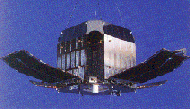|
|
The Tenma [Astro B] Satellite
 Astro B was the second Japanese X-ray astronomy
satellite. After launch on February 20, 1983, it was renamed Tenma (Japanese
for "Pegasus"). Tenma carried GSFC detectors which had an improved energy
resolution (by a factor of 2) compared to proportional counters and
performed the first sensitive measurements of the iron spectral
region for many astronomical objects.
Astro B was the second Japanese X-ray astronomy
satellite. After launch on February 20, 1983, it was renamed Tenma (Japanese
for "Pegasus"). Tenma carried GSFC detectors which had an improved energy
resolution (by a factor of 2) compared to proportional counters and
performed the first sensitive measurements of the iron spectral
region for many astronomical objects.
Mission Characteristics
 Lifetime :
February 20, 1983 - November, 22 1985 Lifetime :
February 20, 1983 - November, 22 1985
 Energy Range :
0.1 keV - 60 keV Energy Range :
0.1 keV - 60 keV
 Payload : Payload :
- Gas Scintillator Proportional Counter:
10 units of 80 cm2 each, FOV ~ 3deg (FWHM), 2 - 60 keV
- X-ray focusing collector:
2 units of 7 cm2 each, 0.1 -2 keV
- Transient Source Monitor: 2 - 10 keV
- Radiation Belt Monitor/Gamma-ray burst detector
 Science Highlights:
Science Highlights:
- Discovery of the Iron helium-like emission from the galactic ridge
- Iron line discovery and/or study in many LMXRB, HMXRB and AGN
- Discovery of an absorption line at 4 keV in the X1636-536
Burst spectra
 Archive:
Not Available at HEASARC
Archive:
Not Available at HEASARC
[Tenma Home]
[About Tenma]
[Gallery]
[Publications]
[All Missions]
[by Time]
[by Energy]
Page authors: Lorella Angelini Jesse Allen
HEASARC Home |
Observatories |
Archive |
Calibration |
Software |
Tools |
Students/Teachers/Public
Last modified: Thursday, 24-Sep-2020 21:25:19 EDT
|
 Astro B was the second Japanese X-ray astronomy
satellite. After launch on February 20, 1983, it was renamed Tenma (Japanese
for "Pegasus"). Tenma carried GSFC detectors which had an improved energy
resolution (by a factor of 2) compared to proportional counters and
performed the first sensitive measurements of the iron spectral
region for many astronomical objects.
Astro B was the second Japanese X-ray astronomy
satellite. After launch on February 20, 1983, it was renamed Tenma (Japanese
for "Pegasus"). Tenma carried GSFC detectors which had an improved energy
resolution (by a factor of 2) compared to proportional counters and
performed the first sensitive measurements of the iron spectral
region for many astronomical objects.
